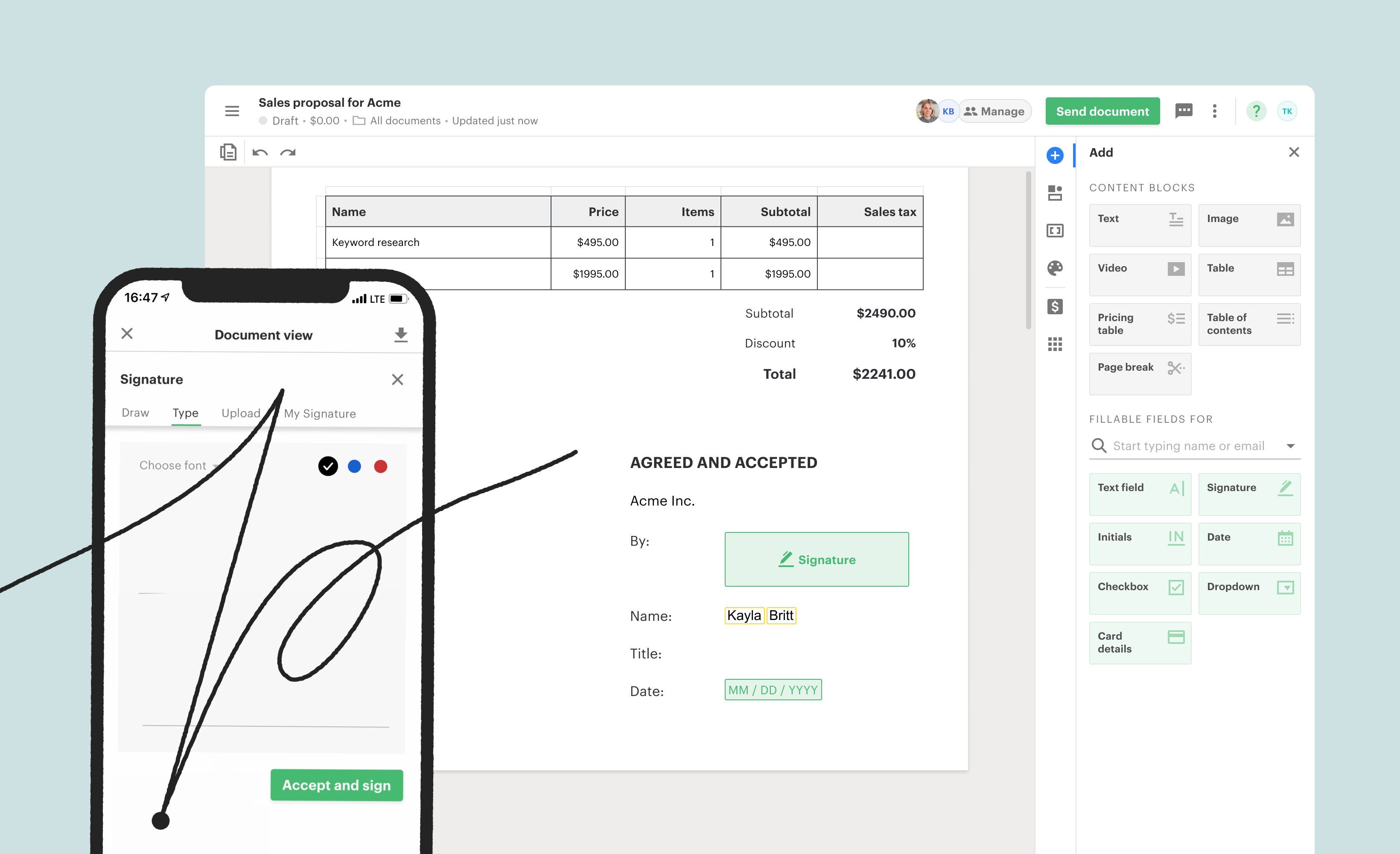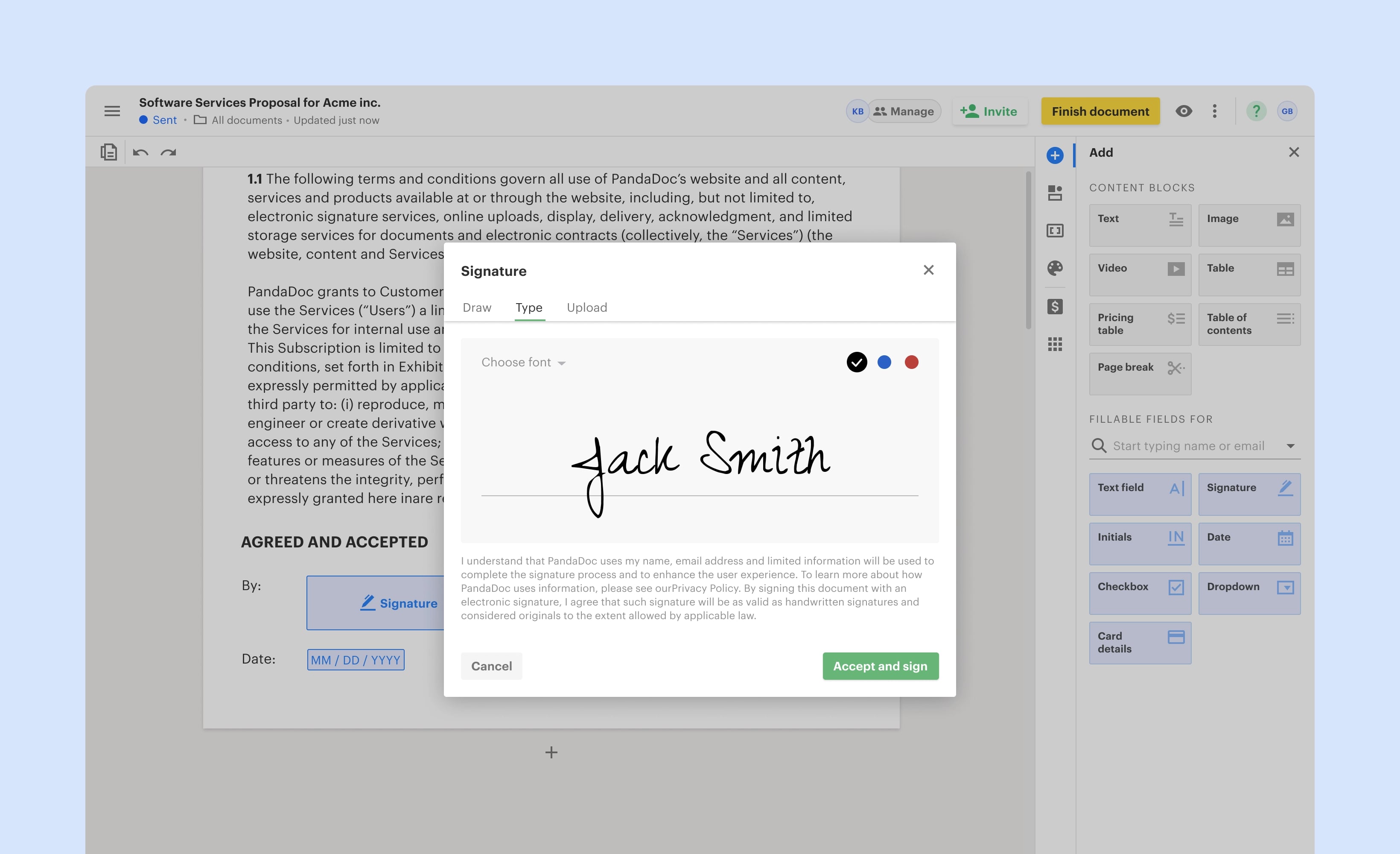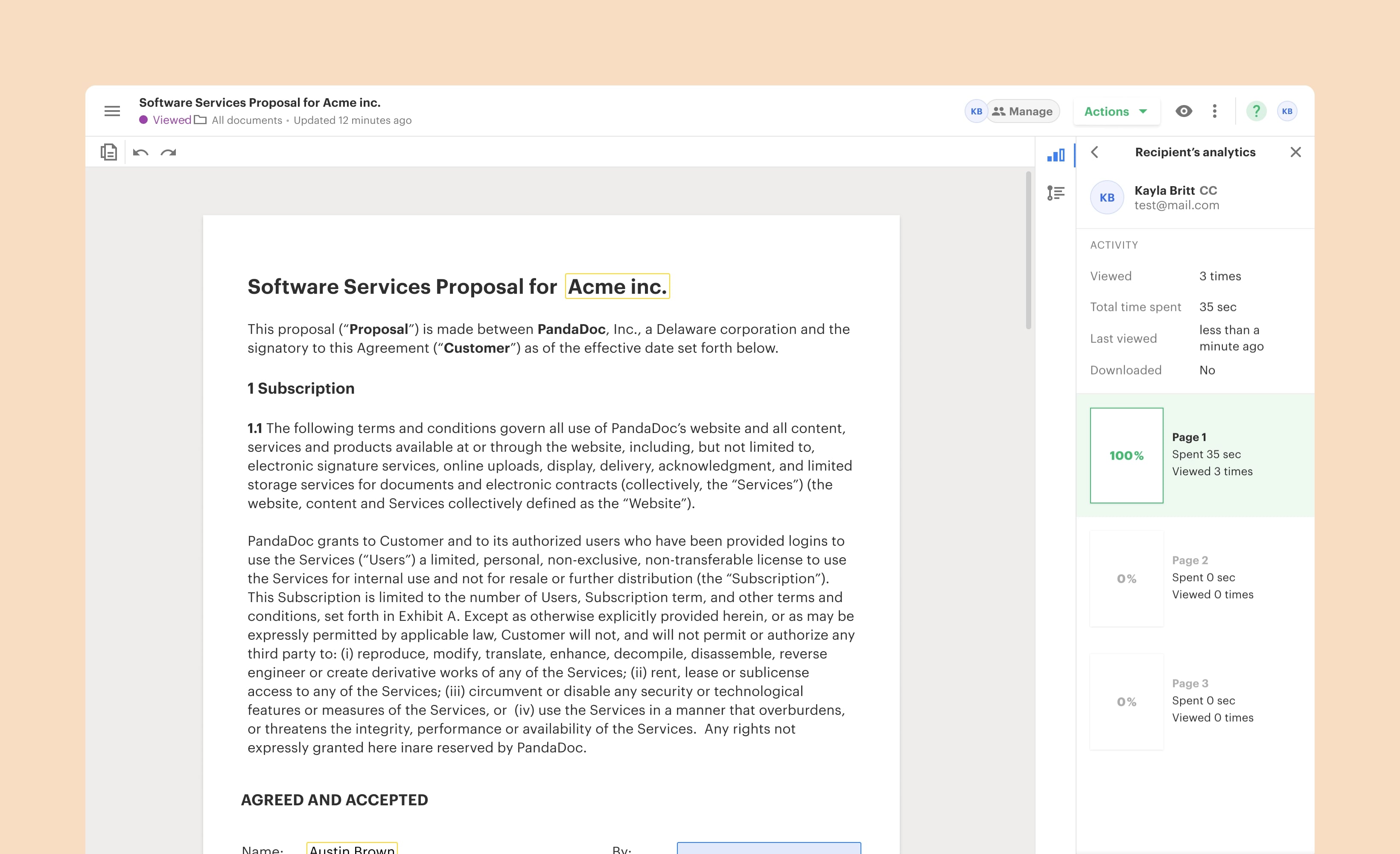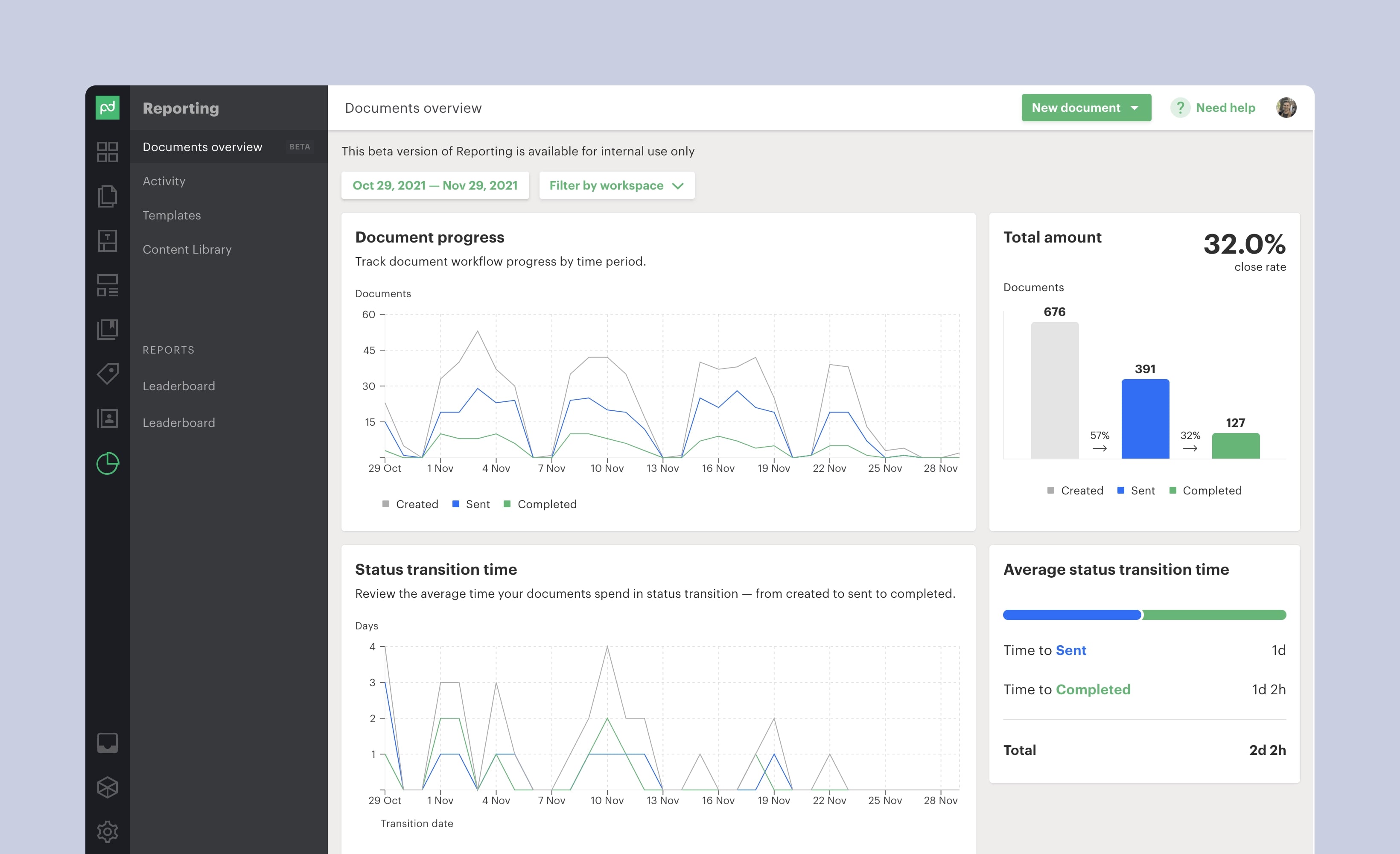PandaDoc


Partnership
Here are the various ways we partner with PandaDoc.
Badges

Not sure where to start? Request a one-on-one consultation with one of our experts.
Consultation

Here are the various ways we partner with PandaDoc.

Not sure where to start? Request a one-on-one consultation with one of our experts.
ConsultationPandaDoc unifies document creation, collaboration, eSignature, payments, and analytics into one platform. It eliminates fragmented quote-to-cash processes, cutting manual work and ensuring compliance. The result is faster cycles, higher win rates, and clear auditability across teams. Its core stack includes a drag-and-drop editor, content library, native CPQ, secure eSignature, and REST API with CRM and payment integrations.

PandaDoc provides modular capabilities that operate independently or as part of an integrated system. This flexibility enables teams to manage proposals, quotes, contracts, renewals, and forms within a single source of truth. Consolidating these workflows enhances governance and compliance while maintaining the flexibility needed for tailored authoring.
PandaDoc’s block-based editor enables teams to assemble documents quickly while maintaining brand consistency. It streamlines authoring with reusable templates, variables, and a central content library. Sales teams can generate proposal packets with case studies and pricing in minutes.
PandaDoc enables legally binding eSignatures with detailed audit trails, role-based fields, and signer authentication. These features help organisations maintain compliance and ensure document integrity across every transaction. HR teams use it to issue offer letters and policy acknowledgements to remote hires with full visibility and security.
PandaDoc’s CPQ tools allow teams to configure price quotes using product catalogs, bundles, and discounts that feed directly into approved templates. This ensures sales reps generate accurate quotes while maintaining compliance with pricing rules. RevOps teams enforce guardrails that eliminate approval bottlenecks and keep deals moving quickly.
PandaDoc supports embedded payments that allow customers to sign and pay in a single step through supported gateways. This accelerates cash collection and reduces administrative friction for service providers. Consulting firms collect deposits at contract signature to improve cash flow predictability.
PandaDoc delivers real-time document status, page-level engagement tracking, and automated reminders that highlight deal risk and coaching opportunities. These insights help managers and sales teams focus on the right accounts at the right time. Account managers prioritise outreach based on recipient activity to improve deal velocity.
The platform scales through cloud native hosting, stateless APIs, and template driven automation. Data residency options and role based controls support regional requirements. Prebuilt integrations reduce custom code while the API supports high volume generation and event driven workflows.

PandaDoc was founded in 2011 in Minsk, Belarus by Mikita Mikado and Sergey Barysiuk. Insights from their earlier venture, Quote Roller, influenced the design of the first editor, template system, and CRM integrations. The company later moved its headquarters to Silicon Valley to gain access to capital, senior talent, and enterprise customers.
Between 2015 and 2018, PandaDoc focused on scaling its operations. A USD 5 million Series A in 2015 funded enhancements to the editor, content library, and connectors. To expand its U.S. presence, the company opened an office in St. Petersburg, Florida, in 2017. Two Series B rounds totaling USD 45 million in 2017 and 2018 advanced eSignature, CPQ, and analytics capabilities to better serve mid-market and enterprise customers.
From 2020 to 2021, PandaDoc faced external shocks yet adapted quickly. In March 2020, it launched Free eSign to support remote transactions during the onset of COVID-19. Later that year, authorities raided the company’s Minsk office, disrupting local operations. By August 2021, Belarusian authorities had closed the case and operations returned to normal.
From late 2021 onward, new funding and product expansion supported PandaDoc’s global scale. In September 2021, the company raised a Series C at a USD 1 billion valuation to accelerate enterprise delivery. In March 2022, PandaDoc acquired LiveNotary and launched PandaDoc Notary, extending its offering to Remote Online Notarization. By August 2024, annual recurring revenue had surpassed USD 100 million, driven by adoption of payments, CPQ, and analytics.
In 2025, the CPQ suite introduced deeper Salesforce and Pipedrive integrations to shorten configuration and approvals.




PandaDoc supports horizontal teams with vertical specific configurations so templates, approvals, and data mappings reflect industry language and obligations.
PandaDoc supports healthcare organisations with HIPAA-aligned templates, Business Associate Agreements, patient forms, and consent flows. These features ensure compliance while protecting sensitive health information. Clinics can digitise intake and referrals with secure audit trails that improve both efficiency and patient trust.
PandaDoc supports advanced pricing workflows with CRM variables, subscription catalogs, and usage-based tables. These features allow teams to generate accurate agreements while aligning pricing directly with customer data. Product-led sales teams can create MSAs and order forms straight from trial usage, reducing friction in the conversion process.
PandaDoc enables structured quoting with BOM-style line items and multi-stage approvals. These capabilities give field sales teams the tools to configure quotes accurately while reflecting regional pricing requirements. Reps can deliver compliant, customer-ready quotes faster without relying on manual approval chains.
PandaDoc provides offer templates, disclosure packets, and integrations with notarisation partners where available. These tools streamline complex real estate and rental agreements while ensuring compliance and auditability. Agencies can issue listing agreements and rental contracts for eSignature in a secure, standardised format.
PandaDoc equips higher education institutions with admission offer templates, grant agreements, and vendor contracts that support delegated approvals. These tools simplify complex academic and procurement processes while maintaining compliance and accountability. Universities can streamline procurement workflows and manage student acknowledgements with greater efficiency and oversight.
PandaDoc is used globally to create, approve, sign and track proposals, quotes, contracts and renewals in a single workflow. Templates with variables reduce manual entry and errors. Analytics and audit trails provide visibility for compliance, risk and coaching. Integrations with Salesforce, HubSpot, Pipedrive, Google and Microsoft keep records current. The platform holds SOC 2 Type II certification and uses encryption in transit and at rest. Growth is sustained across Asia Pacific and Oceania.
Adoption is consistent across Australia and New Zealand, led by professional services, events, software and industrials. Deployments typically include GST and ABN fields in templates, local card acceptance for sign and pay with finance reconciliation, and clear audit trails. Rollouts often begin in one market and scale regionally using shared libraries and role based access.
Growth is supported by localisation and partner enablement in key markets such as Singapore, Japan and India. Teams emphasise CRM connected templates, bilingual or dual currency documents where needed, and approval rules aligned to regional policies. Payments are enabled where permitted, and integrations with Salesforce and HubSpot keep records current across subsidiaries.
PandaDoc supports enterprises across software, services, manufacturing, and events. Typical outcomes include faster document cycles, fewer errors, and clearer audit trails. Key players in Australia include:





These organisations use PandaDoc to standardise templates, automate approvals, and capture compliant eSignatures. Sales teams produce accurate quotes using CPQ configured pricing tables. Finance enables sign and pay to bring cash forward. Integrations with Salesforce, HubSpot, and Pipedrive keep CRM records aligned across regions.
Insights present decision‑useful evidence from documented deployments in APAC and other regions. Use these metrics and patterns to plan rollout, set targets, and manage risk.
| Metric | Value |
|---|---|
| Customers | 68,000 plus |
| ARR | USD 100 million as of Aug 27, 2024 |
| Security | SOC 2 Type II on AWS |
| Payments | Stripe support for sign and pay |
Case studies show measurable gains when templates, approval rules, and CRM variables are standardised.
| Company | Outcomes |
|---|---|
| Arinex | Close rate up to 32 percent higher and proposal creation time reduced by 25 percent with branded templates and analytics |
| Mercury ISS | Proposal build time reduced by about 91 percent to roughly 15 minutes, supporting 50 percent annual revenue growth and 10 plus hours saved per week |
| Stackla | Single workflow for document creation and eSignature with Salesforce connected proposals, reducing rework and improving consistency |
PandaDoc occupies a clear position in document workflow and eSignature by unifying authoring, pricing, signatures, payments and analytics in one platform. The advantages become evident when compared with leading alternatives.
DocuSign is recognised for enterprise eSignature breadth and compliance. It typically relies on adjacent tools for rich authoring and quoting, which can add cost and administration.
PandaDoc:
Adobe is strong for PDF centric workflows and document standardisation. Dynamic collaboration and pricing logic usually require additional tools.
PandaDoc:
Dropbox Sign is valued for simplicity in basic signature tasks. It offers limited support for complex quoting or multi document packages.
PandaDoc:
Yes when used with the platform’s audit trail, signer attribution, and consent flows, in line with major eSignature regulations.
Yes using supported payment gateways so recipients sign and pay in one workflow with transaction records stored alongside the document.
Customer data is encrypted in transit and at rest, with independent audits and reports available under NDA, plus granular access controls and detailed activity logs.
Prebuilt connectors exist for leading CRMs, payment gateways, productivity suites, and data platforms. The API and SDKs support custom extensions.
Data residency options are available and contractual addenda can be executed to address regional privacy obligations and sector regulations.